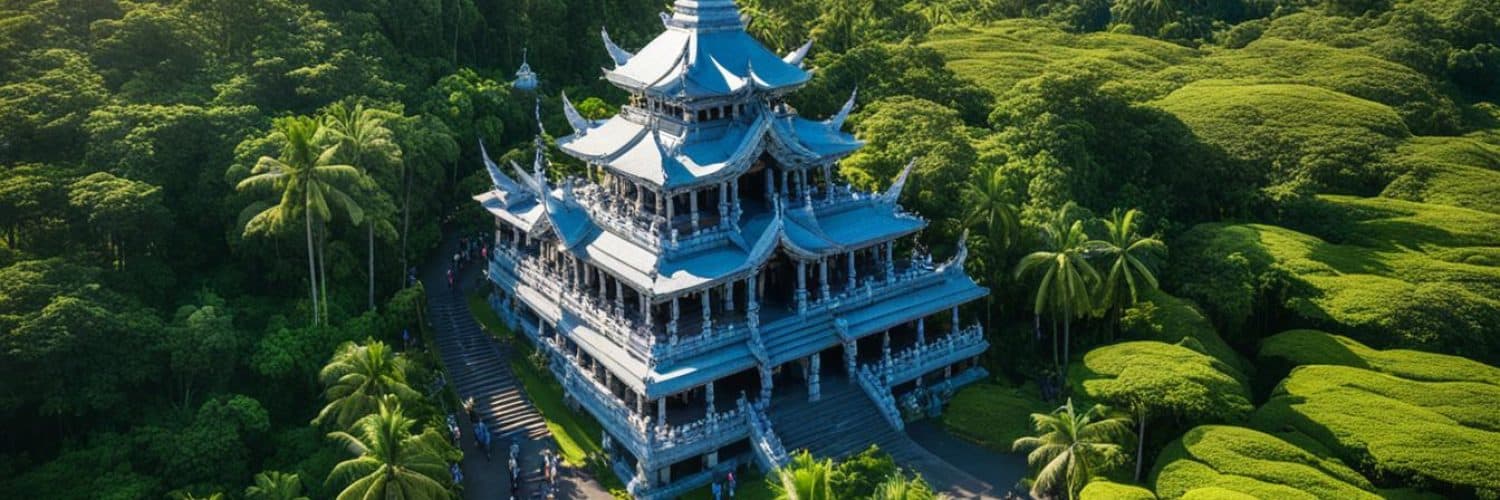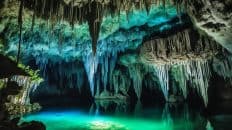If you’re planning a trip to Bohol, Philippines, make sure to include a visit to the Cogon Shrine on your itinerary. This historical site is not only a tourist destination but also a religious sanctuary and a cultural landmark.
The Cogon Shrine, also known as the Shrine of the Birhen Sa Barangay, is located in the Cogon District of Tagbilaran City in Bohol. It features modern architecture and beautiful landscaped surroundings, creating a serene and peaceful atmosphere for visitors.
Inside the shrine, you’ll find a large crucifix beneath a dome, as well as statues of the Birhen Sa Barangay and the Blessed Sacrament. This religious sanctuary holds significant importance to the local community and has become a pilgrimage site for devotees.
Not only is the Cogon Shrine a place of spiritual significance, but it is also a must-visit destination for tourists. The combination of historical value, architectural beauty, and natural surroundings makes it one of the top attractions in the Philippines and a must-visit place in Bohol.
Key Takeaways:
- The Cogon Shrine is a historical and religious sanctuary in Bohol, Philippines.
- It is a popular tourist destination and a must-visit place in Bohol.
- The shrine features modern architecture and beautiful landscaped surroundings.
- Inside, you’ll find a large crucifix, statues, and a peaceful atmosphere.
- The Cogon Shrine has both cultural and religious significance.
The History of Cogon Shrine
The Cogon Shrine holds a rich history that dates back to the late 1960s. The idea of constructing the shrine was conceived by two priests, Reverend Father Didi de los Pueblos and Reverend Father Margarito Gonzaga, who envisioned a place of spiritual significance for the community. Encouraged by Bishop Manuel Mascarinas, construction commenced in 1970 on a 5,843 sq. m. lot.
Fundraising activities and generous donations from the community provided the necessary support for the construction of the shrine. However, the declaration of Martial Law in 1971 brought temporary halting to the project. Despite this setback, the community persevered, and the shrine was eventually completed.
Finally, in 1976, the Cogon Shrine was dedicated as a diocesan shrine, marking a significant milestone in its history. The devotion and dedication of the local community had transformed the vision of Reverend Father Didi de los Pueblos and Reverend Father Margarito Gonzaga into a tangible reality.
The Cogon Shrine represents a testament to the rich history and spiritual significance within the community.
The Birhen Sa Barangay Image
The image of the Birhen Sa Barangay, the patron saint of the Cogon Shrine, holds a significant place in the history and artistic representation of the shrine. Painted by Crisogono A. Domingo, an inmate of Santa Barbara Leprosarium, the image portrays the Blessed Virgin Mary and Child. It was inspired in Cadiz City in 1954, and blessed by Msgr. Emmanuel Yap, D.D. in the same year. This exquisite piece of art was acclaimed for its divine inspiration.
In 1975, the image made its way to the Diocese of Tagbilaran, where it became an integral part of the Cogon Shrine. This profound work of religious art was personally blessed by Pope John Paul II in 1981, solidifying its spiritual significance and connection to the shrine.
The Birhen Sa Barangay image serves as a powerful representation of faith and devotion within the Cogon Shrine. Its presence elicits a sense of awe and reverence, attracting visitors from far and wide who seek solace and inspiration in its artistic beauty.
The Growth of Cogon Shrine
Over the years, the Cogon Shrine has undergone significant renovations and additions, thanks to the efforts of the Parish Economic Council. The council, formed in 1993, has been instrumental in spearheading the improvements on the church campus, ensuring its continuous growth as a place of worship and community engagement.
One of the notable additions to the Cogon Shrine is the development of a parish center, equipped with function rooms that accommodate various community events and programs. This center has become a hub of activity, fostering a sense of unity and camaraderie among parishioners and visitors.
In addition to the parish center, a rectory was constructed to provide a dedicated space for clergy members, enabling them to better serve the spiritual needs of the congregation. The rectory serves as a place of residence and reflection for the priests, ensuring a welcoming and accessible presence within the church.
Furthermore, the Cogon Shrine expanded its facilities with the construction of a Perpetual Eucharistic Adoration Chapel, providing a peaceful and sacred space for perpetual adoration and communion with the divine. This chapel offers a serene atmosphere for prayer and reflection, allowing individuals to deepen their connection to their faith and spirituality.
Another aspect of the growth of the Cogon Shrine is its continuous beautification efforts. The frontage of the church was fenced, enhancing the overall aesthetics and providing a sense of security and serenity. Additionally, a lighted grotto of Our Lady of Lourdes was built, serving as a visual representation of devotion and symbolizing the importance of Mary in the Catholic faith.
Overall, the dedication of the Parish Economic Council and the continuous renovations and beautification projects have transformed the Cogon Shrine into a vibrant and thriving spiritual center. With its expanded facilities, including the parish center, perpetual adoration chapel, and captivating landscaping, the shrine serves as a testament to the unwavering commitment of the community in creating a welcoming and uplifting environment for worship and contemplation.
| Renovations and Additions | Year |
|---|---|
| Parish Center Construction | 1993 |
| Rectory Establishment | 1993 |
| Perpetual Eucharistic Adoration Chapel Construction | 1993 |
| Frontage Fencing | 1993 |
| Lighted Grotto of Our Lady of Lourdes | 1993 |
Attractions in Garcia Hernandez of Bohol
Garcia Hernandez, a charming town located in Bohol, offers a variety of attractions that are sure to captivate visitors. From mystical caves with underground streams to breathtaking waterfalls and rejuvenating springs, this town is a haven for nature lovers and adventure seekers. But that’s not all, Garcia Hernandez is also home to a magnificent Roman Catholic Church that dates back to the late 19th century.
Exploring Natural Wonders
A visit to Garcia Hernandez is incomplete without delving into its fascinating caves, where visitors can unravel hidden natural treasures. These caves offer an immersive experience of exploring underground streams and witnessing awe-inspiring rock formations. As you navigate through the dark passageways, you’ll feel a sense of adventure and wonder.
The town is also blessed with picturesque waterfalls that cascade down lush green cliffs, creating a mesmerizing sight. These waterfalls provide a serene backdrop for nature enthusiasts to relax and unwind in the midst of pristine beauty. Additionally, the rejuvenating springs in Garcia Hernandez offer a tranquil setting for visitors to immerse themselves in the refreshing waters and rejuvenate mind, body, and soul.
A Glimpse into History and Spirituality
The Roman Catholic Church in Garcia Hernandez is a testament to the town’s rich history and deep-rooted spirituality. Built in 1880 and completed in 1896, this church stands as a symbol of architectural grandeur and religious significance. Dedicated to St. John the Baptist, it boasts a separate belfry, adding to its unique charm.
The church’s stunning architecture and intricate details will leave you in awe as you step inside to explore its hallowed halls. Whether you’re seeking a moment of reflection or simply appreciating the craftsmanship, the Roman Catholic Church in Garcia Hernandez is a place where history and spirituality seamlessly merge.
Enhancing Tourism in Garcia Hernandez
The local government of Garcia Hernandez recognizes the potential of these natural and man-made attractions to boost tourism in the area. Efforts are underway to enhance the accessibility and infrastructure surrounding these attractions, ensuring that visitors can experience the wonders of Garcia Hernandez in the most enjoyable way possible.
By continuously investing in its natural beauty and preserving its historical landmarks, Garcia Hernandez aims to attract more tourists, providing them with unforgettable experiences and a deeper understanding of the town’s unique heritage and offerings.
| Attraction | Description |
|---|---|
| Caves | Mystical caves with underground streams and breathtaking rock formations. |
| Waterfalls | Breathtaking waterfalls cascading down lush green cliffs. |
| Springs | Rejuvenating springs offering a tranquil escape amidst nature. |
| Roman Catholic Church | A historic church dedicated to St. John the Baptist, showcasing remarkable architecture. |
Semana Santa and Visita Iglesia in Bohol
Semana Santa is an annual tradition observed by Christians worldwide, commemorating the passion and death of Jesus Christ. In the province of Bohol, this important religious event is deeply rooted in the local culture and includes the practice of Visita Iglesia, a pilgrimage to multiple churches.
During Semana Santa, devotees and tourists alike participate in Visita Iglesia to explore and pray in various churches across Bohol. This pilgrimage allows visitors to immerse themselves in the rich spiritual heritage of the province while embracing its unique traditions.
Bohol is home to several churches that are commonly visited during Visita Iglesia. Here are five notable churches that are part of this meaningful pilgrimage:
- Mother of Perpetual Help Chapel
- Maribojoc Church
- Calape Church
- Loon Church
- St. Joseph the Worker Cathedral
“Visita Iglesia in Bohol offers a profound experience for pilgrims to connect with their faith and appreciate the historical and architectural beauty of these sacred sites.” – Father Juan Dela Cruz
Recommended Route for Visita Iglesia
| Church | Location | Architectural Style |
|---|---|---|
| Mother of Perpetual Help Chapel | Cortes, Bohol | Baroque Revival |
| Maribojoc Church | Maribojoc, Bohol | Baroque |
| Calape Church | Calape, Bohol | Neoclassical |
| Loon Church | Loon, Bohol | Baroque |
| St. Joseph the Worker Cathedral | Tagbilaran City, Bohol | Modern |
Visitors are advised to follow this recommended route for efficiency and convenience, ensuring ample time for prayer, reflection, and appreciation of the architectural marvels that these churches represent.
Whether you are a devout pilgrim, a history enthusiast, or simply someone seeking a unique cultural experience, participating in Semana Santa and Visita Iglesia in Bohol is a rewarding journey that allows for spiritual growth and deepens one’s appreciation for the rich traditions and heritage of the province.
Seven Churches to Visit in Bohol
In the beautiful province of Bohol, there are several churches that attract both pilgrims and tourists. These churches are not only religious landmarks but also hold significant historical and architectural value. Here are seven churches in Bohol that are worth visiting:
Mother of Perpetual Help Chapel
Located in Cortes, the Mother of Perpetual Help Chapel is a charming church known for its serene ambiance. The chapel’s architecture and peaceful surroundings make it an ideal place for prayer and reflection.
Maribojoc Church
The Maribojoc Church, also known as Our Lady of the Assumption Parish Church, is a Spanish-era church that displays a unique blend of Gothic and Neo-Romanesque architectural styles. Its historic bell tower and stunning stained glass windows are a must-see.
Calape Church
The Calape Church, officially named San Vicente Ferrer Church, is one of the oldest churches in Bohol, dating back to the 19th century. Its intricate facade and the beautiful retablos inside make it a significant religious and cultural site.
Loon Church
The Loon Church, officially known as the St. Peter the Apostle Parish Church, is one of the oldest churches in Bohol, constructed during the Spanish colonial period. Its coral stone facade and massive wooden doors showcase remarkable craftsmanship.
Birhen sa Kalooy Chapel
The Birhen sa Kalooy Chapel in Calape is a small yet enchanting chapel located on a hill. Its panoramic views of the surrounding countryside make it a serene place for worship and contemplation.
Birhen Sa Barangay Parish Church
Situated in the heart of Tagbilaran City, the Birhen Sa Barangay Parish Church is a modern church that stands out with its uniquely designed architecture. Its contemporary style provides a refreshing contrast to the traditional churches in Bohol.
St. Joseph the Worker Cathedral
The St. Joseph the Worker Cathedral, the seat of the Diocese of Tagbilaran, is an impressive structure that showcases a combination of modern and symbolic elements. Its stained glass windows and towering altar create a sense of grandeur and reverence.
Each of these churches in Bohol offers a unique experience, combining religious significance, architectural beauty, and historical value. Whether you’re a religious pilgrim or a curious traveler, exploring these churches will provide a deeper understanding of Bohol’s rich cultural heritage.
| Church | Location | Architectural Style |
|---|---|---|
| Mother of Perpetual Help Chapel | Cortes | N/A |
| Maribojoc Church | Maribojoc | Gothic and Neo-Romanesque |
| Calape Church | Calape | Spanish colonial |
| Loon Church | Loon | Spanish colonial |
| Birhen sa Kalooy Chapel | Calape | N/A |
| Birhen Sa Barangay Parish Church | Tagbilaran City | Modern |
| St. Joseph the Worker Cathedral | Tagbilaran City | Modern |
Tips for Visiting the Churches in Bohol
When embarking on a Visita Iglesia in Bohol, it’s essential to plan your trip efficiently to make the most of your time and ensure a meaningful experience. Here are some valuable tips to help you navigate and explore the churches of Bohol:
- Start Early: Begin your day early to allow sufficient time to visit all the churches on your itinerary. The churches may have specific opening and closing hours, so planning your trip accordingly will help you avoid disappointment.
- Consider Transportation: Having your own car or motorcycle can offer flexibility and convenience in traveling between the churches. Alternatively, public transportation options such as tricycles or local buses are available, but be sure to check their schedules in advance.
- Check Opening Hours: Before setting out on your Visita Iglesia, verify the opening hours of each church. This will help you plan your visits and avoid any unexpected closures or maintenance activities.
- Dress Appropriately and Respectfully: As you enter the sacred spaces, it’s important to dress modestly and respectfully. Refrain from wearing revealing or inappropriate attire to demonstrate reverence for the religious significance of these places.
By following these tips, you can ensure a smooth and enriching Visita Iglesia experience, immersing yourself in the spiritual and historical atmosphere of Bohol’s churches.
Conclusion
The Cogon Shrine in Bohol, Philippines is an extraordinary destination that encompasses spirituality, history, and natural splendor. With its profound historical significance, captivating architectural design, and religious importance, the shrine has emerged as a premier tourist attraction and a must-visit site in Bohol. Whether you are embarking on a pilgrimage or seeking out cultural landmarks, the Cogon Shrine is an unmissable gem that should be on your itinerary when exploring Bohol.
This sacred shrine not only showcases the rich history of Bohol but also offers a serene and peaceful atmosphere for visitors to reflect and find solace. The remarkable architecture of the shrine, paired with its stunning landscaped surroundings, creates a mesmerizing ambiance that leaves a lasting impression on every visitor.
As you enter the Cogon Shrine, you will be immersed in a world of spirituality and beauty. The shrine’s compelling historical background and its status as a religious landmark make it an enriching spot for both locals and international travelers. The Cogon Shrine stands as a testament to the deep religious devotion and cultural heritage of the people of Bohol.
Don’t miss the opportunity to experience the Cogon Shrine’s unique blend of history, spirituality, and awe-inspiring beauty when you visit Bohol. Whether you are seeking a sacred pilgrimage site, exploring historical landmarks, or indulging in the wonders of architecture, the Cogon Shrine offers an unforgettable journey that will leave you with cherished memories of your time in Bohol, Philippines.
FAQ
What is the Cogon Shrine?
The Cogon Shrine, also known as the Shrine of the Birhen Sa Barangay, is a historical and religious sanctuary located in the Cogon District of Tagbilaran City in Bohol, Philippines. It is a circular edifice known for its modern architecture and beautiful landscaped surroundings.
When was the Cogon Shrine built?
Construction of the Cogon Shrine began in 1970 and was completed in the early 1970s. It was dedicated as a diocesan shrine in 1976.
Who conceived the idea of building the Cogon Shrine?
The idea of building the Cogon Shrine was conceived by two priests, Rev. Fr. Didi de los Pueblos and Rev. Fr. Margarito Gonzaga, in the late 1960s.
What is the significance of the Birhen Sa Barangay image?
The Birhen Sa Barangay image is the patron saint of the Cogon Shrine. It was painted by an inmate of Santa Barbara Leprosarium named Crisogono A. Domingo and was personally blessed by Pope John Paul II in 1981.
What attractions are there in Garcia Hernandez, Bohol?
Garcia Hernandez in Bohol has attractions such as caves with underground streams, waterfalls, springs, and a Roman Catholic Church built in 1880 dedicated to St. John the Baptist.
What is Semana Santa and Visita Iglesia in Bohol?
Semana Santa is an annual tradition where Christians commemorate the passion of Jesus Christ. In Bohol, the tradition includes Visita Iglesia, a pilgrimage to several churches across the province.
Which churches are commonly visited during Visita Iglesia in Bohol?
Some of the commonly visited churches during Visita Iglesia in Bohol include the Mother of Perpetual Help Chapel, Maribojoc Church, Calape Church, Loon Church, and St. Joseph the Worker Cathedral.
How should I plan my visit to the churches in Bohol for Visita Iglesia?
It is advisable to start early to ensure enough time to visit all the churches on your itinerary. Having your own car or motorcycle can be helpful for transportation. It is also recommended to check the opening hours of the churches and dress appropriately when entering the church premises.
What are the tips for visiting the churches in Bohol?
Tips for visiting the churches in Bohol include starting early, having your own transportation, checking the opening hours, and dressing appropriately and respectfully when entering the church premises.


















Add comment